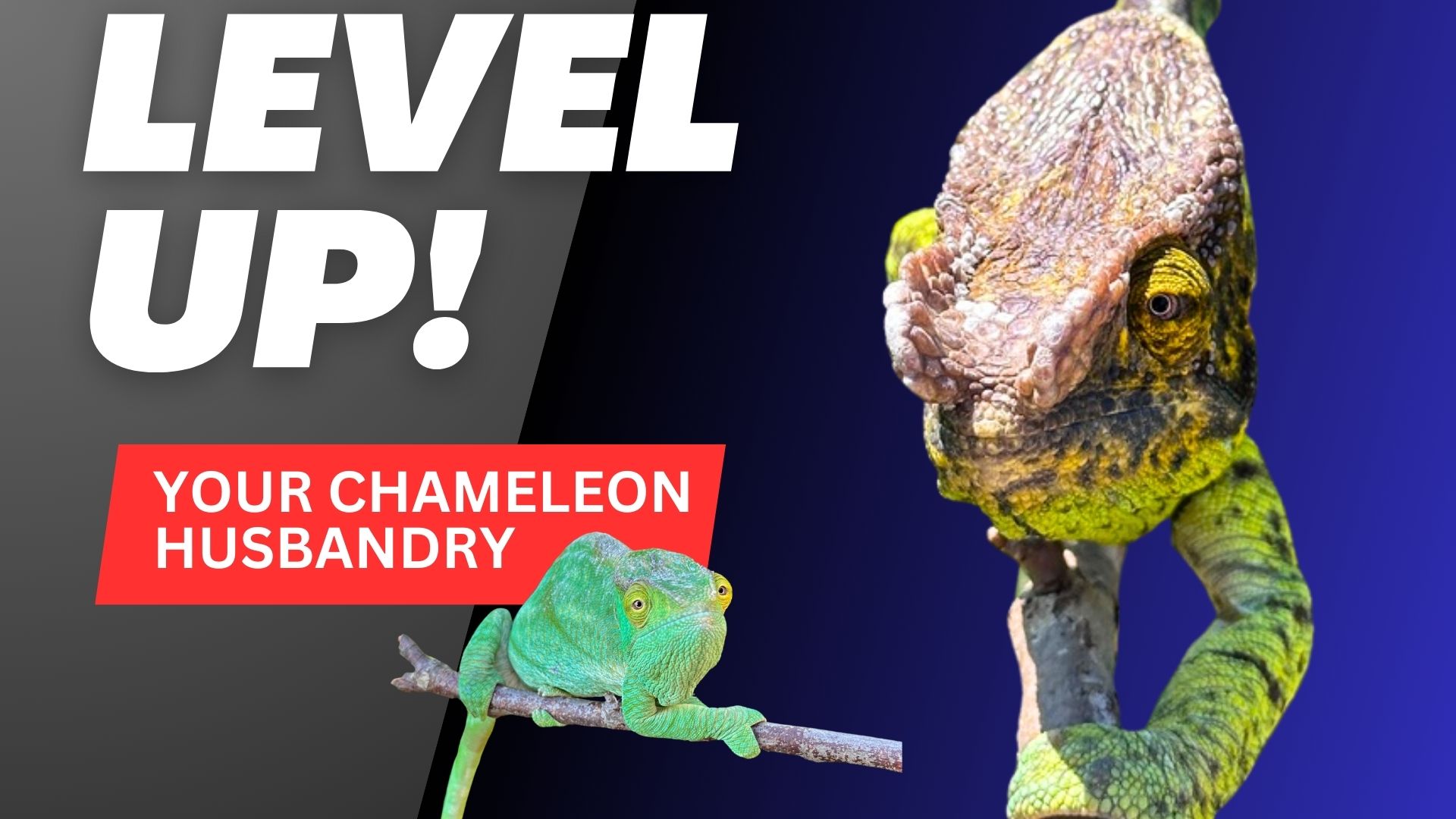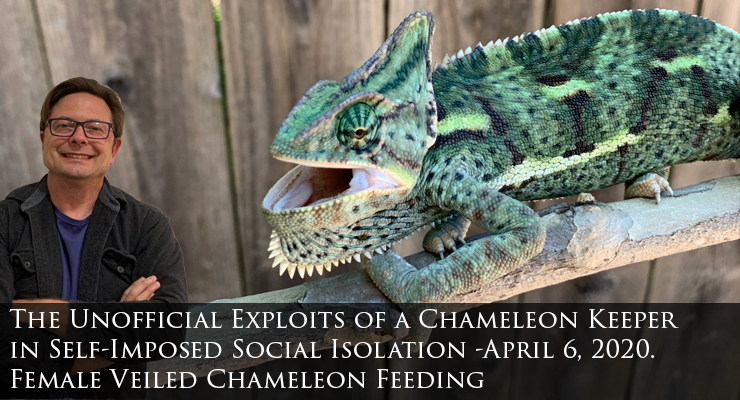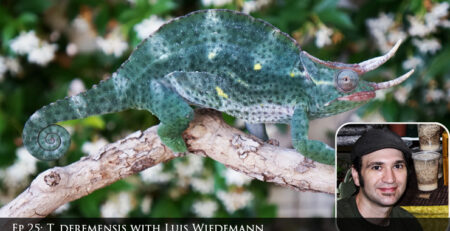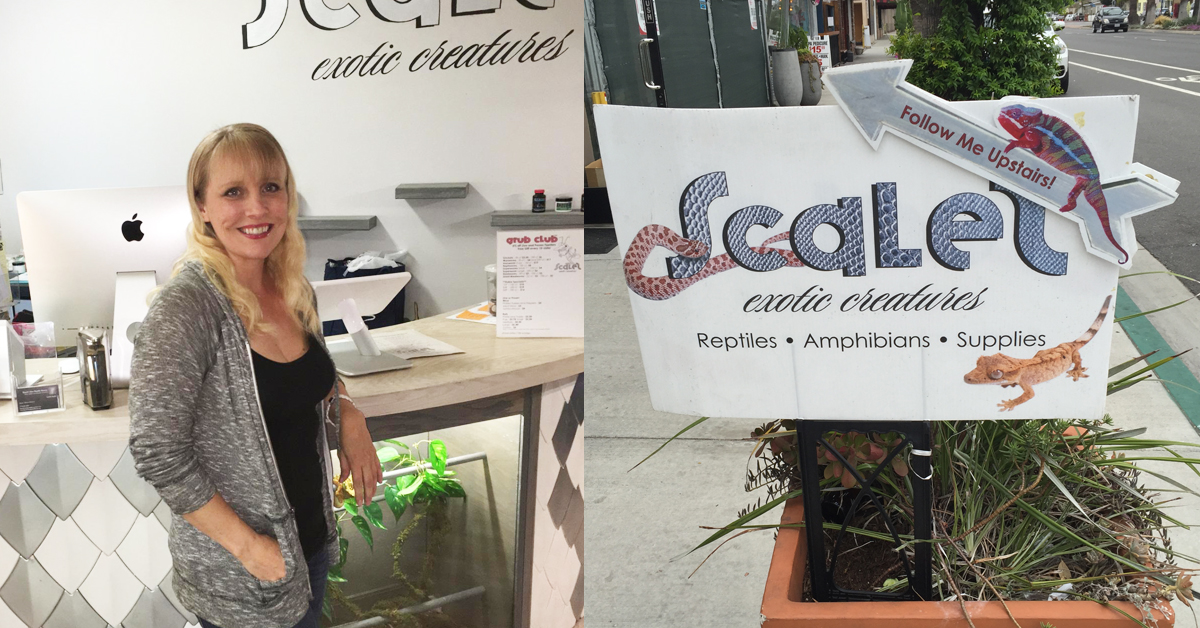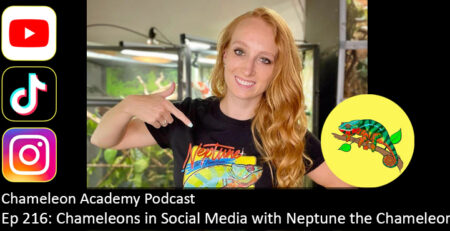Level up Your Chameleon Husbandry
Once we get our chameleon cage set up and our chameleon is showing signs that they like the cage we get a boost of confidence. Good job! We know there is always room for improvement and we will always be learning, but once our chameleon has accepted the cage we have offered to it we can spare a moment to feel good about it!
In that moment it is common for keepers to be ready for the next step. You got the cage basics of cage, lights, mister, fogger, and plants. You have put the cage together like the care guides or your breeder said to and you are wondering what the next step is. Today we talk about what are the next steps, after setting up the cage properly, for the chameleon keeper to go to?
Note: This topic is discussed in the weekly Chameleon Academy Newsletter and is reviewed in both a YouTube video and a podcast episode. The video and podcast are separately produced and will provide different perspectives. Click here to join in with the weekly newsletter discussions: Chameleon Academy Newsletter sign up
Video Player
Podcast Player
Here are my picks for the next steps for chameleon keepers.

1. Get A Solarmeter 6.5 UVB meter
I just have to get this one out of the way first. My first step is to invest in a Solarmeter 6.5. This is the UVB meter that will allow you to measure the output of your UVB lights which are, of course, invisible to our eyes. And, by the way, the visible light that comes off of them is not the UVB light! Other wavelengths are produced as well. Your UVB light will still be producing visible light long after it was stopped producing UVB light. Being able to dial in your chameleon’s UVB exposure is a husbandry basic. The cost is about $225 but you could easily argue that the savings in not replacing UVB lights until they truly need to be replaced would make up for that cost.
The thing is that UVB lights don’t produce a consistent level of UVB. At the beginning they spike high, then stabilize, but degrade over time. And the levels are affected by the cage top screen filter and the fixture the bulb is in. So, even though I create distance charts on Chameleon Academy Care guides for people who cannot yet get a Solarmeter, these charts are only an approximation that give you an average level over the year. At the beginning it will be higher and at the end it will be lower than the target. It is better than nothing, but there is no way to truly be accurate in your UVB unless you get a Solarmeter 6.5. Now, there are always cheap UVB detection devices and products that come out. Goodness knows I would love for something to come out that is not over $200, but, unfortunately, there is nothing that has been able to be a reliable as the Solarmeter 6.5. So, that remains the meter that is worth saving up for! And, it is so worth it. With the meter you are able to pin point the exact distance your UVB bulb needs to be away from the basking branch and, with monthly checks you can adjust as needed. You are also able to keep your lights longer and save money on replacements because you don’t get rid of your bulb until it is truly done with its effective life. So, the UVB meter allows you to have better husbandry and saves you money in the long term. I strongly recommend getting one as soon as you are able!
Action Item: Get a Solarmeter 6.5 as soon as you are able to. Amazon link is here: SolarMeter 6.5 UVB meter

2. Get a Microscope
My next recommendation is to get a microscope. There is a whole world under the microscope that exists all around us, but out of our vision. Beyond just the fascination of the microscopic world, having a microscope allows us to monitor our chameleon’s internal status. Mainly, of course, to check for parasites. The immense benefit of doing constant checks for parasites is that you are able to catch any infection in its early stages. In the early stages there is no external sign of parasites. If a chameleon is lethargic, won’t eat or sitting with its eyes closed, the infection is raging inside and your chameleon is weakened. Their life may be hanging in the balance to where it is risky to treat and risky not to treat. What I mean by this is that, in a raging infection, you have to treat to kill the parasites, but if you do treat you could suddenly fill your weak chameleon’s body with all those dead parasites. We call that necrotic shock where the body is overwhelmed having to process all that dead and decaying material that suddenly appears in all corners of the body. This can kill the chameleon. And if your chameleon is already weak, the odds are not in your favor. So, catching the infection early means you can treat when the chameleon is in the prime of health and the body will be able to handle cleaning the blood of dead bodies with no problem.
Now, I know many of you think this does not concern you. You got a captive hatched baby from a reputable breeder. Well, part of the process of digging deeper into the chameleon arts is the realization that parasites are not uncommon in breeding colonies. It is unknown how many chameleons are harboring parasites without any external signs because they have good husbandry with hygienic practices. And they could go their whole life and never show signs. But if something happens and the immune system is weakened, the parasites can suddenly spiral out of control. This is where you have a chameleon suddenly go downhill. I created a digital course called Hunting Microscopic Chameleon Parasites where students learn how to get the equipment, set up the tests, and identify parasites. The alumni have tested their bearded dragons, frogs, and other reptiles and amphibians and have come back with some wonderful pictures! Of course, they are pictures only a parasite nerd would love and the animals need to be treated, but these parasites were flying under the radar all this time.
It isn’t terribly expensive to get involved. New microscopes run a couple hundred dollars and can be found on classified for much less. We really do not need anything fancy to find parasites. The real challenge is learning how to identify the parasites. For that there are books, videos, and, of course, need I mention, yet again, an entire course created specifically to teach chameleon people how to find parasites?
Action Item: For directly relevant training in doing efecal tests for your chameleon at home, click here to get more information about the digital course Hunting Microscopic Chameleon Parasites.

3. Breed a Chameleon Feeder Insect
My third suggestion is to select a feeder and breed it. Grow your own food. At least chameleon food! Now, we want to give our chameleon as much variety as possible and you will soon be spending every waking hour taking care of bugs if you try to do that by yourself. But, it is well worth it to pick one staple feeder and learn how to breed it and keep a colony going. The benefits of this are two fold. First, you never have to worry about your chameleon going hungry in the crazy world of ours where deep freezes can kill any feeders mailed to you or baking days where the mailtruck’s tires melt on the way to deliver a box of dead feeders to your door. And then there are hurricanes, tornados, and other unexpected natural disasters. Not to mention the occasional pandemic that has us all sitting at home. You get the idea. Things happen in this world and if you are able to be self-sufficient for a week or two you are ahead.
the second benefit is that you can make sure your feeders are richly gutloaded. When you get feeders in the mail you have no idea what they have been raised on. We can all suspect they have been raised on the minimum that gets them up to size and to your door. When you are in charge of what they are fed you can make sure your chameleon is getting the nutrition it deserves. Nothing can replace the care of a chameleon mom or dad.
If you are taking this step then some good candidates to try are Dubia roaches, superworms, or crickets. If you have a mulberry tree then silkworms can be a possibility. There are a myriad of other options and it all depends on what you can handle and what interests you. I suggest starting with one first and get that one down. You will find it takes a lot of work and a lot of time. Some are easier than others, but they all take a chunk of effort! But, I can tell you that it is worth it. Both in the capability it gives you to feed your chameleon and in the experience it gives you to strengthen your husbandry skills.
Action Item: Pick a feeder, research its care and breeding, and bring in a starter colony!

4 - Go to Madagascar to see chameleons in their natural habitat
Finally, a great step to take is to travel to see chameleons in the natural habitat. There is no substitute for seeing how chameleons live in the wild. You can study the numbers all you want (and, you should), but it doesn’t really give you the full understanding until you are standing right there looking at a chameleon on a tree in Madagascar and you are feeling what it feels like. You get a deep understanding of the relationship between temperature and humidity where it is important.
There are a number of places you can go. Madagascar is a common choice. It is a great place to go because of how many chameleons are there and how it is geared for eco tourism. It is easy to find tour guides and it is easy to get in the country. There are no venomous snakes there and if you just aren’t much of a camper you will be amazed at how much you can see driving along the road and taking easy day hikes! I have a trip for Chameleon Academy members that will go in January and we will visit the places that cover the majority of the species that are imported so there is a definite herpetoculture focus with this trip. But it shouldn’t be difficult to find groups going or even to set something up yourself.
The realistic side, though, is that this is an expense. It can easily be $6k when you take into account all costs and it is, literally, on the other side of the earth for some people. Europe is closer, but for me, personally, if you find the other side of the Earth it is in the waters by Madagascar. so, it is in the category of once in a lifetime trips. But, it is a once in a lifetime experience and it is an amazing trip. You will come back with great memories and an uncommon insight. I spent way too much of my life not having visited Madagascar. I encourage you to create that special opportunity for yourself.
Action Item: If you are interested in learning more about going to Madagascar with the Chameleon Academy, the best place to stay in touch is the newsletter. The 2025 trip is full, but we will open up discussion for the 2026 trip at the end of January 2025. You will be notified through the weekly newsletter. Click here to join: Chameleon Academy Newsletter

Wait a minute!...What about breeding chameleons?
Now, some of you may notice that I conspicuously left breeding your chameleon off this list. It is a definite next step. But I am thinking that it is time in our community development that we distance ourselves from seeing that as the next step. To be sure, that was THE number one next step for the first three decades of my chameleon keeping life. But that led to some painful times for some people. It is a huge project that many people jumped to before they were prepared. They rushed it and it didn’t turn out well. Surprisingly, the community is very behind on breeding with proper husbandry. We have spent so much time figuring out how to do it efficiently that we have lost our way as far as doing it with top husbandry in mind. So, honestly, I am going to pull back on encouraging people to go down that road. If you want to breed, the information is there and I sure give a lot of it. Breeding and raising up hatchlings is my passion so you will get full support from me! But if someone gets into breeding because of something I have said I want them to do it fully prepared to do it right. Spoiler alert, group raising babies is not the right way. And I would like us to get away from the concept that breeding is a sign of your expertise. We have this strange dynamic that anyone who wants to be seen as an expert starts breeding. The truth is that breeding is now a recipe to follow. Sure, it was a challenge in the 1980s, but it isn’t a challenge any more. Breeding does not make you an expert! Sure, there are still rare species that need dedicated breeders to work with them and aren’t easy at all, but panthers and veileds aren’t those species!
The problem with breeding is that you can do it wrong and call yourself an expert. It is very hard to do it right. The good news is that more and more breeders are raising babies individually so we are on the right track. But I am going to suggest you do all the fun things I am mentioning in this episode before you tie yourself down with a breeding project! Make breeding the third tier project you work on with your growth in the chameleon herpetocultural arts!
In closing...
What could be better than a mini tree dragon? How about a bunch of baby mini tree dragons? Breeding is a goal for many keepers and I have to say that raising chameleon hatchlings is one of my favorite hobbies. But it is full of joy-sucking challenges. For example, chameleons should be kept separately. That requires a great deal of infrastructure or else you are bin raising them and the experience when the smaller ones are bullied and you aren’t able to monitor the health of each one turn it into an experience to get through instead of one to be enjoyed. Breeding is a great experience, but it is a significant step that needs to be gone into with serious preparation and planning.
The bottom line here is that you keep growing. Some people are content keeping a chameleon in a cage and that is good enough. Other people make chameleon herpetoculture their conduit to learn about the world. Obviously, I have embraced the latter approach. And it has been an incredible ride which I love sharing with you in this podcast, YouTube video channel, website, newsletter!
Join me for a weekly discussion about chameleons
These topics are meant to be a discussion. If you would like to be part of the discussion, I introduce the topic in the Chameleon Academy newsletter which goes out every week. Each newsletter has a topic and I get feedback from the readers which I share in the subsequent newsletter and sometimes on the podcast and/or YouTube video. Yes, I share my decades of experience, but the Chameleon Academy has always been about the community and the perspective is greatly enriched when I hear from you. You can sign up for the newsletter here: Chameleon Academy Weekly Newsletter
And, with that, I think it is time for us to go out into that world and be awesome! Thank you for joining me on this journey to explore chameleon husbandry and the relationship between us and our chameleons. This is Bill Strand singing off. I will see you next time!

